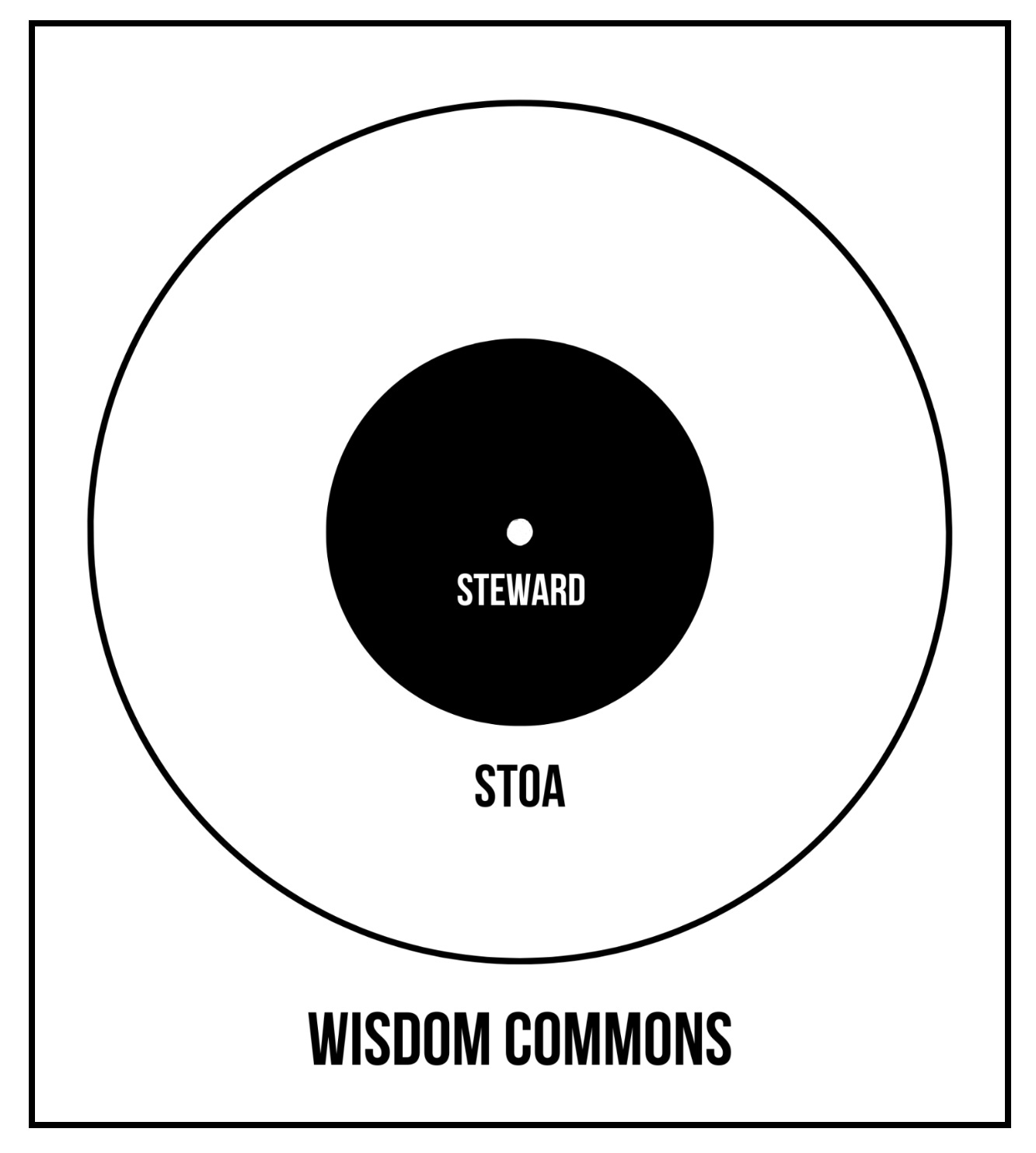I will speak at the “Midwifing a Wisdom Commons” session on April Fool's Day, hosted by Being and Becoming, a philosophy group in Toronto run by Ph.D. students in philosophy. I was a keynote speaker at one of their soirees in February, discussing the merits of private philosophy.
Rather than always hosting them, it was pleasant being the philosophical main event for a change. I am glad groups like Being and Becoming have filled the vacant philosophical event space I once was responsible for in Toronto. I exclusively hosted in-person events before The Stoa started four years ago, then exclusively hosted online events for over three years. The Stoa went on hiatus last summer, and now it seems to want to make a comeback.
I never knew what The Stoa was or wanted. When it came to life in 2020, this was its first description:
The Stoa was once a covered portico where Stoics met to philosophize. Now it’s a space, where we can gather and talk about what matters most, at the knife’s edge of this pandemic.
The phrase “knife's edge” became a thing amongst Stoans, even becoming my rap name (yes, we had philosophical freestyle rap sessions back then):
Stewarding The Stoa became dispirited because I lost sight of what it was, leading me to pause it last June. I recently realized it was the knife's edge part that went missing. The Stoa's birthday was on Thursday, and it made a surprise return. The Kali Yuga blues opened the space, bringing us back to those timeless days with knife-edge vibes and bodies zooming on delicious hope.
I dislike labeling what The Stoa was because doing so killed the vibe. As I wrote in the second description, via negativa is the best way to think about The Stoa, followed by weird terms with an over-the-top poetic flare:
The Stoa is not a school, think tank, clinic, or commune, and it is definitely not a fucking YouTube channel. The Stoa is a stewarded daemonic fire—on an obscure hill in the noosphere—serving as a beacon to find the others. It is a surprise, for those who have become weary of the endless pressure to know. It is also a portal, to a new world. A world that you might have stopped believing in, but have always been secretly longing for.
The main pattern matching that often occurred was The Stoa being labeled as a YouTube channel or podcast and a “community.” It was never a YouTube channel, podcast, or a community,1 especially an “online” one. I've always been irritated by this pattern matching. To be fair, under the prevailing consensus realities, these labels were the most evident.
Sometimes, once it was realized that The Stoa did not conform to any of the conventional categories mentioned above, people joked that it was a “cult.” This label is commonly applied to new things that evoke a communal feeling with spiritual undertones. I disliked these jokes. Such jokes subtly reveal a hidden desire to be part of a cult. While the negative aspects of cults are widely acknowledged, their allure lies in the pleasure derived from them. Surrendering to a leader who fills social fields with ecstasy and confidently offers clear direction in life, as though possessing ultimate knowledge on how to live, seemingly makes life easier to live. What fools they are.
The closest label of The Stoa I feel aligned with is a term from sociologist Philip Rieff: “lifework,”2 which refers to art that emphasizes the sacred, bringing people together around the knife's edge of what matters most. Lifeworks are contrasted to “deathworks,” art that deemphasizes the sacred, fragmenting people into their egos, which makes them easily controllable. When one buckles up and creates with the “daemon” in a way not bound by the constraints of an artistic genre, the only thing that can emerge is a lifework. Lifeworks create new artistic genres.
New artistic genres are needed today. There is “art anxiety” in the air. Many are worried that AI will take over not only their jobs but also their art. All the classical genres are at risk, especially in the market economy, because AI will soon be able to create the most scintillating “art” imaginable. In essence, they will be weapons-grade deathworks. We'll need to start creating lifeworks to open up new timelines.
I can only speculate what kind of artistic genre The Stoa is becoming, and I created these images to imagine it…
The “steward” role is what Peter Koenig refers to as “source,” the one who creatively sources an initiative. Koenig argues that there can only be one source at a time, while many in “The Liminal Web”3 embrace the idea that multiple people can be the source. I like the term steward because it means being responsible for something you do not own. I like the term “stoa” because the ancient Greek stoas were covered porticoes, public but protected, fulfilling many purposes, including philosophers philosophizing.
I see (meta)modern stoas as spaces where true philosophizing occurs in ways that allow the ensuing wisdom to ripple out in surprising and unpredictable ways. These wise social fields are “Wisdom Commons,” the places where wisdom becomes common. In spirit, a Wisdom Commons breathes between bodies residing in subtle realms, which are impossible to track through network maps.
I see multiple Wisdom Commons competing against each other (or playing with one another). Wisdom Commons makes the world wiser, and what fool would not want that? I like the notion of The Stoa returning with a “living question,” a question one lives with without forcing an answer. The living question we lived with this Thursday was related to my Philosopher-in-Residence position at Daylight:
How do we get right with technology?
While this may not be the properly worded question, it gets at the spirit of what feels knife-edgy for us right now. Understandably, there are great fears around our present accelerative technological situation. Many fools are at the helm of creating such technology. Something feels right about bringing The Stoa back with such a living question and staying with its complexity until clarity unfolds.
Whatever The Stoa is, the knife’s edge has to be at its heart. But what is the knife’s edge?
It's when something is on the line. It's when the “meta-crisis” becomes less meta, with the weight of the world awakening in our bodies. It's a balance of not knowing what's happening while knowing what to do. It's where eros and thumos finally dance, then get a room where they make love until daylight, creating each other through mutual surrender.
Anyway, it evades description. Those who know, know. Those who do not will judge from the fear-based rationalist side-lines, getting acceleratingly sucked into a timeline where the world burns. Not us. That's not our timeline. That's not what we choose. Instead, we vibe with delicious hope… This time, it will be alright. It's time to move on. Turn the page. Things going to be different. This time, not like the last. This time, we will get it...
So, is The Stoa back?
Yeah, The Stoa’s back.
If you have any questions, insights, feedback, or criticism on this entry or more generally, message me below (I read and respond on Saturdays) …
The “Terrible Communities” series displays my displeasure with the overuse of the word “community.”
For more on lifeworks, see the “Deathworks to Lifeworks: Disclosing the New Artistic Genre” entry.
I currently disagree.








